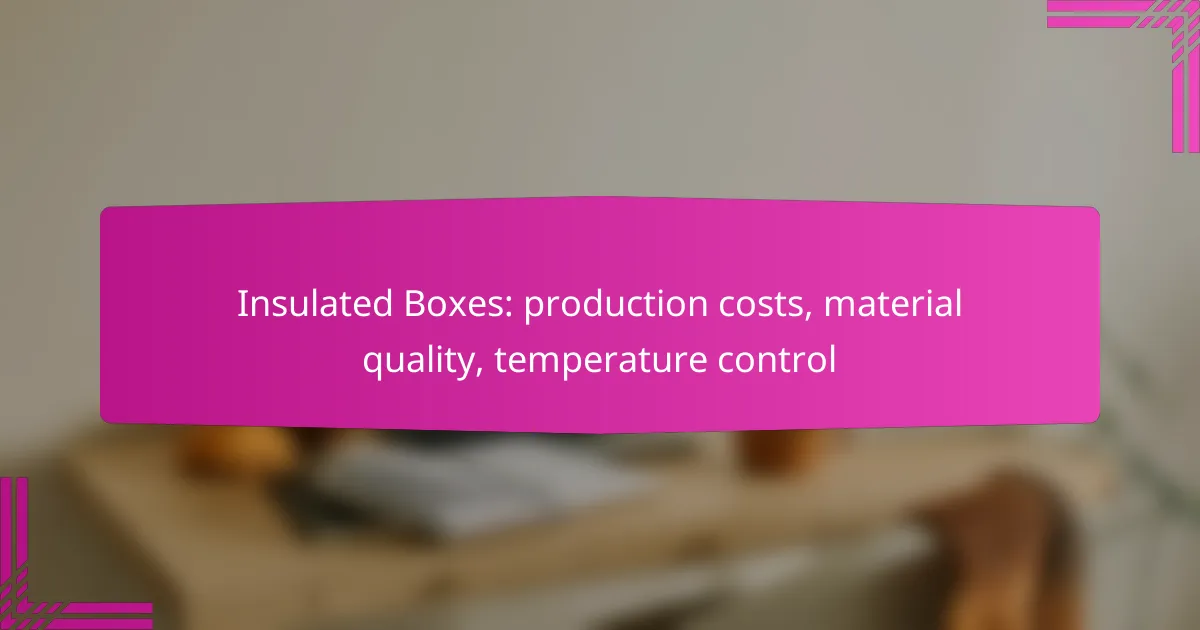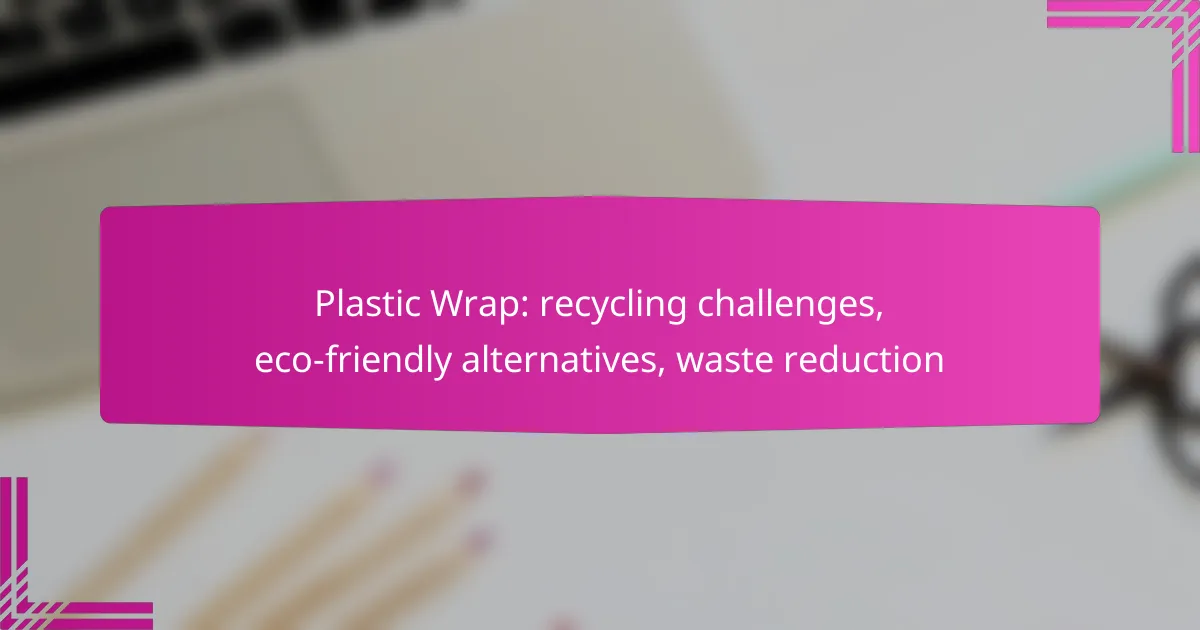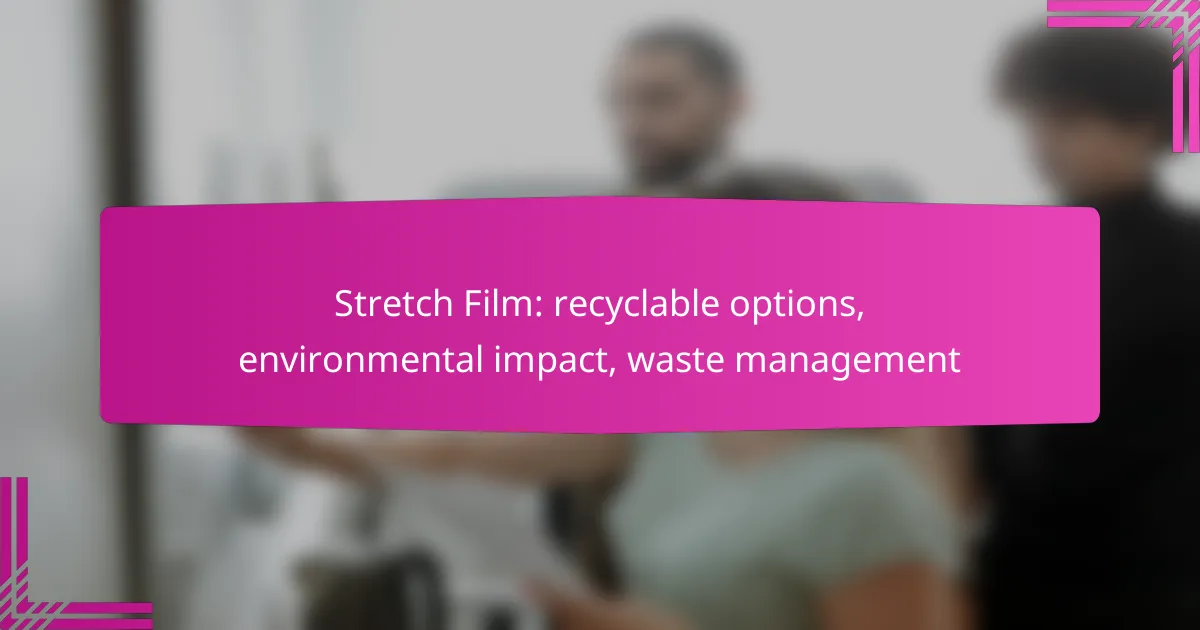Insulated boxes are essential for maintaining temperature stability in various applications, and their production costs in New Zealand are influenced by factors such as material quality and labor expenses. The choice of high-quality materials significantly enhances thermal performance and durability, ultimately affecting the overall cost. Proper insulation techniques and sealing methods are critical for ensuring effective temperature control, safeguarding the contents from extreme environmental conditions.

What are the production costs of insulated boxes in New Zealand?
The production costs of insulated boxes in New Zealand vary based on several factors, including material quality, labor expenses, and market demand. Generally, these costs can range from moderate to high depending on the specifications and intended use of the boxes.
Material costs
Material costs for insulated boxes primarily depend on the type of insulation used, such as polystyrene, polyurethane, or fiberglass. High-quality materials can significantly increase the overall cost, often ranging from NZD 10 to NZD 30 per unit, depending on insulation thickness and durability.
When selecting materials, consider not only the upfront costs but also the long-term benefits, such as energy efficiency and durability. Investing in superior materials may reduce replacement or maintenance costs over time.
Labor expenses
Labor expenses in New Zealand can be a substantial part of the production costs for insulated boxes. Wages for skilled workers typically range from NZD 25 to NZD 40 per hour, depending on experience and location. Efficient production processes can help mitigate these costs.
To optimize labor expenses, consider training programs that enhance worker skills and productivity. Streamlining operations through automation can also reduce reliance on manual labor, leading to cost savings.
Manufacturing overhead
Manufacturing overhead includes costs related to utilities, equipment maintenance, and facility expenses. These costs can add an additional 20% to 30% to the total production costs. Proper budgeting for overhead is essential to ensure profitability.
Regular maintenance of equipment can prevent costly breakdowns and improve efficiency. Implementing energy-efficient practices may also lower utility costs, contributing to reduced overhead expenses.
Shipping and logistics
Shipping and logistics costs for insulated boxes can vary widely based on distance and shipping methods. Local deliveries may cost less, while international shipping can significantly increase expenses, sometimes exceeding NZD 100 per shipment.
To manage shipping costs effectively, consider consolidating shipments or negotiating rates with logistics providers. Utilizing local suppliers can also reduce transportation expenses and lead times.
Market demand impact
Market demand plays a crucial role in determining the production costs of insulated boxes. High demand can lead to increased prices for materials and labor, while low demand may result in discounts and lower production costs. Understanding market trends is essential for pricing strategies.
To stay competitive, regularly assess market conditions and adjust production levels accordingly. Engaging with customers to understand their needs can help align production with demand, minimizing excess inventory and associated costs.
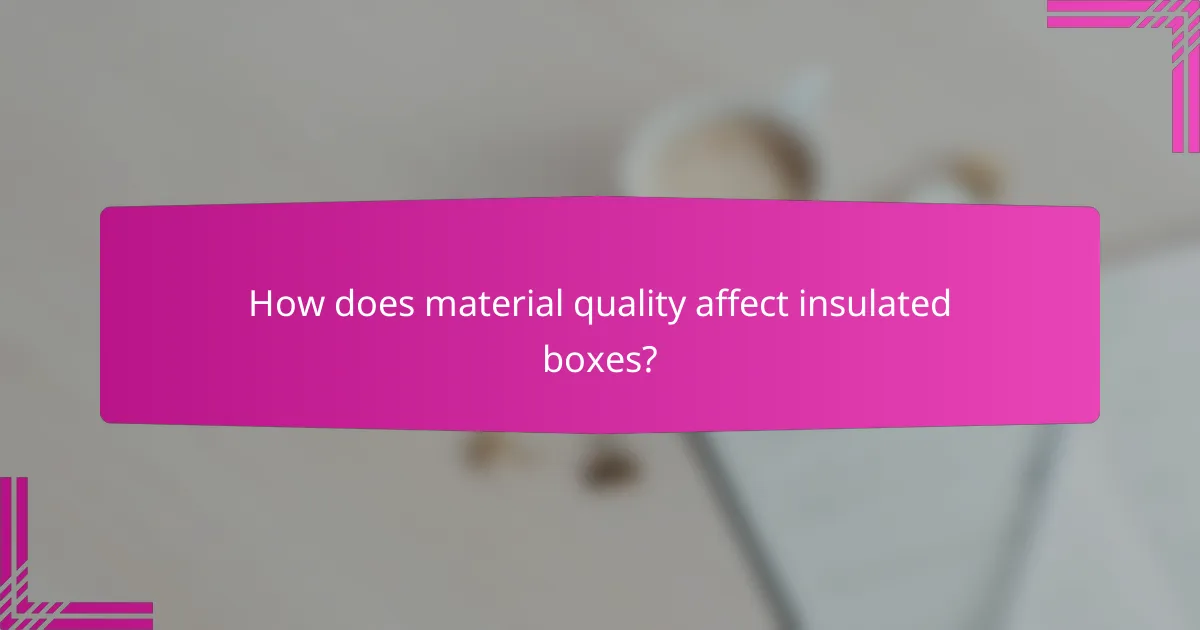
How does material quality affect insulated boxes?
Material quality plays a crucial role in the effectiveness of insulated boxes, influencing their thermal performance, durability, and overall cost. Higher quality materials typically offer better insulation properties, leading to improved temperature control and longevity.
Types of insulation materials
Common insulation materials for insulated boxes include expanded polystyrene (EPS), polyurethane foam, and fiberglass. EPS is lightweight and cost-effective, making it popular for many applications, while polyurethane foam offers superior insulation but at a higher price point. Fiberglass is durable and resistant to moisture but can be heavier and less efficient in some scenarios.
When selecting insulation materials, consider the specific temperature range and conditions the box will face. For instance, if the box will be exposed to extreme temperatures, high-performance materials like polyurethane may be necessary.
Durability and lifespan
The durability of insulated boxes largely depends on the quality of the materials used. High-quality insulation materials can withstand environmental stressors, such as moisture and temperature fluctuations, leading to a longer lifespan. For example, a well-constructed polyurethane insulated box can last several years with proper care.
Conversely, lower-quality materials may degrade faster, resulting in reduced insulation effectiveness and a shorter lifespan. Regular inspections and maintenance can help identify any wear and tear early, ensuring the box remains functional over time.
Cost vs. performance analysis
When evaluating insulated boxes, it’s essential to balance cost and performance. Higher quality materials often come with a higher upfront cost but can lead to savings in energy efficiency and replacement costs over time. For instance, investing in a high-performance insulated box may reduce energy consumption by a significant percentage, offsetting the initial investment.
Consider the specific needs of your application when making a decision. If the insulated box will be used frequently or in demanding conditions, opting for better materials may provide a better return on investment in the long run. Always compare the total cost of ownership, including maintenance and energy savings, rather than just the initial purchase price.
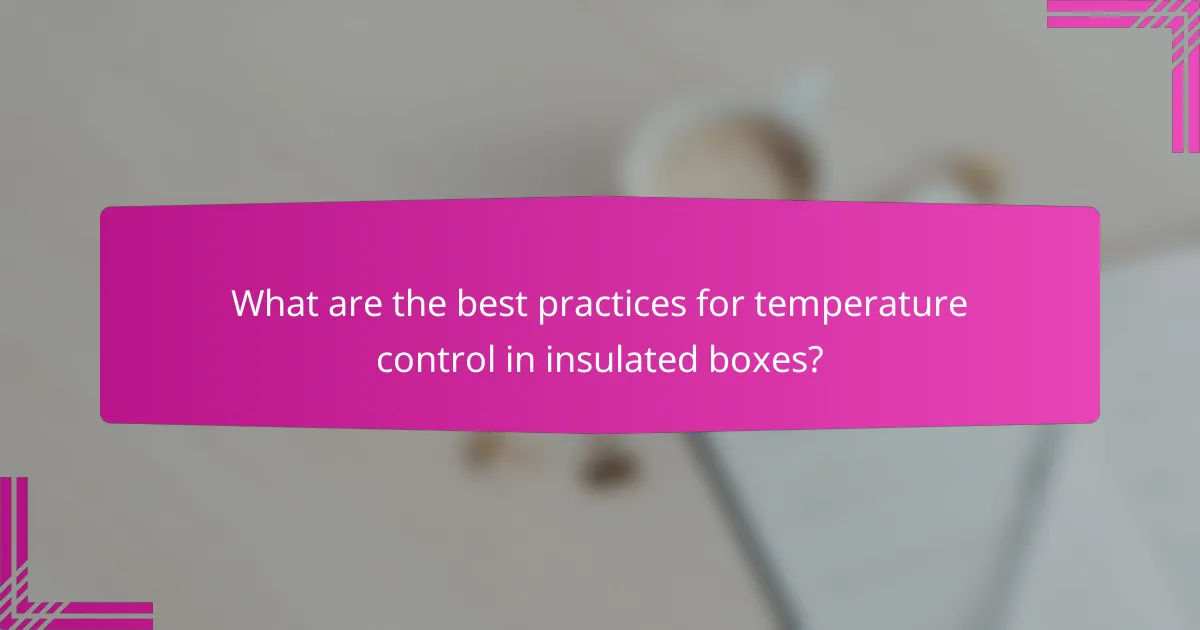
What are the best practices for temperature control in insulated boxes?
Effective temperature control in insulated boxes relies on proper insulation materials, thickness, and sealing techniques. These practices ensure that the internal temperature remains stable, protecting the contents from extreme heat or cold.
Insulation thickness recommendations
The thickness of insulation significantly impacts the thermal performance of an insulated box. Generally, a thickness of 2 to 4 inches is recommended for most applications, balancing weight and insulation efficiency. Thicker insulation may be necessary for extreme temperature conditions or longer transport times.
When selecting insulation thickness, consider the specific use case, such as transporting perishables or sensitive equipment. For example, medical supplies may require more robust insulation compared to general food items.
Sealing techniques
Proper sealing is crucial for maintaining temperature control in insulated boxes. Gaskets and seals should be used around all openings to prevent air leaks, which can compromise insulation effectiveness. A common practice is to utilize high-quality silicone or rubber seals that can withstand temperature fluctuations.
Ensure that all seams and joints are tightly sealed, and consider using adhesive tapes designed for insulation to reinforce these areas. Regular inspections for wear and tear can help maintain optimal performance.
Temperature monitoring solutions
Implementing temperature monitoring solutions is essential for ensuring that insulated boxes maintain the desired temperature. Digital temperature loggers can provide real-time data and alerts if temperatures deviate from set thresholds. These devices are particularly useful for sensitive shipments.
For added reliability, consider using temperature indicators that change color if a certain temperature is exceeded. This visual cue can help quickly identify potential issues during transport.
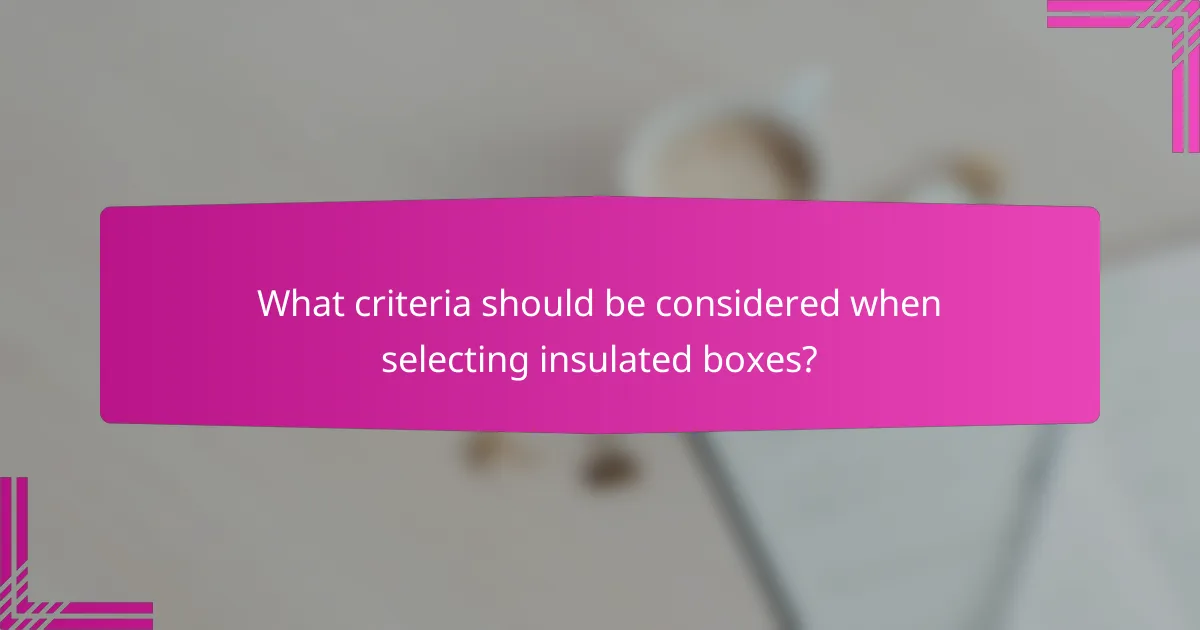
What criteria should be considered when selecting insulated boxes?
When selecting insulated boxes, key criteria include intended use cases, regulatory compliance, and cost-effectiveness. Each factor plays a significant role in ensuring the box meets specific temperature control needs and quality standards.
Intended use cases
Understanding the intended use cases for insulated boxes is crucial. Different applications, such as food transportation, medical supplies, or industrial materials, may require varying levels of insulation and temperature control. For instance, food-grade insulated boxes must adhere to strict hygiene standards, while medical transport boxes often need to maintain specific temperature ranges to ensure product efficacy.
Consider the environment in which the box will be used. For example, insulated boxes used in hot climates may need enhanced insulation materials to prevent heat transfer, while those in colder regions might focus on retaining warmth. Tailoring the box to its specific use case ensures optimal performance.
Regulatory compliance
Regulatory compliance is a vital consideration when selecting insulated boxes, particularly for industries like food and pharmaceuticals. Boxes must meet local and international standards, such as FDA regulations for food safety or ISO standards for medical transport. Non-compliance can lead to product spoilage and legal repercussions.
It’s essential to verify that the materials used in the insulated boxes are approved for their intended application. For example, food-safe materials should be free from harmful chemicals and contaminants. Always check for certifications that demonstrate compliance with relevant regulations.
Cost-effectiveness
Cost-effectiveness is a key factor in the selection of insulated boxes. While higher-quality materials may come with a higher upfront cost, they often provide better insulation and durability, leading to long-term savings. It’s important to evaluate the total cost of ownership, which includes initial purchase price, maintenance, and potential losses from temperature failures.
When assessing cost-effectiveness, consider the volume and frequency of use. For businesses that require frequent shipments, investing in high-quality insulated boxes can reduce the risk of product loss and improve customer satisfaction. Compare options across different suppliers to find the best balance between quality and price.
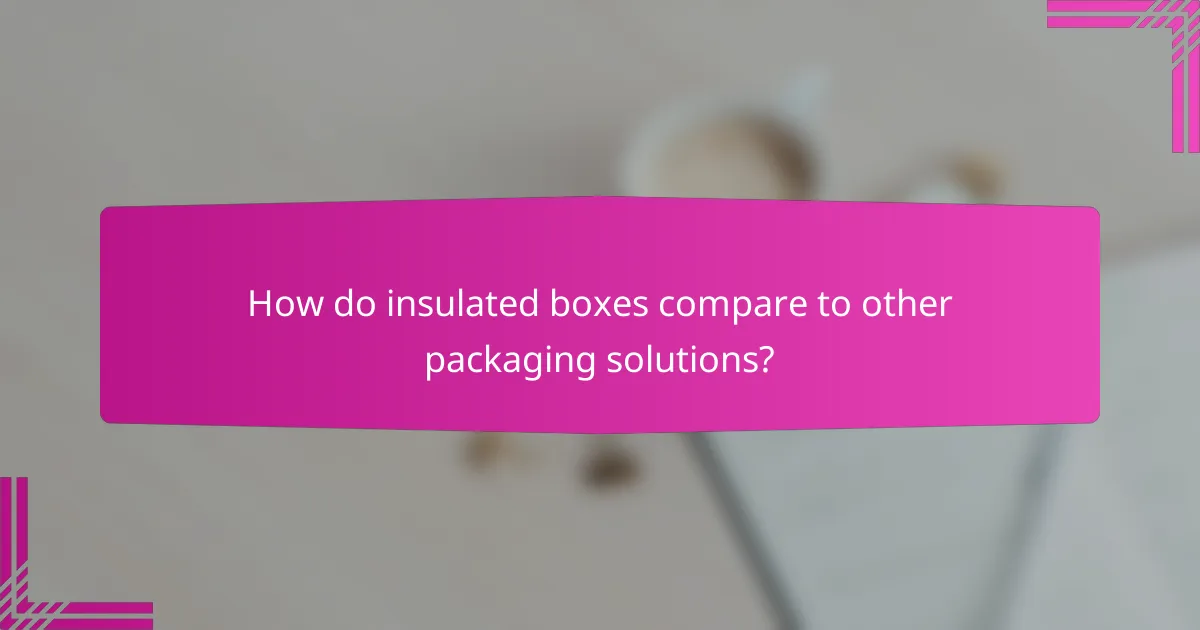
How do insulated boxes compare to other packaging solutions?
Insulated boxes provide superior temperature control compared to standard packaging options, making them ideal for transporting temperature-sensitive goods. Their design and materials help maintain the internal temperature, which is crucial for perishable items like food and pharmaceuticals.
Production costs
The production costs of insulated boxes can vary significantly based on materials and manufacturing processes. Generally, they are more expensive to produce than conventional boxes due to the specialized insulation materials used, such as expanded polystyrene or polyurethane.
When considering production costs, it’s essential to factor in the long-term savings from reduced spoilage and waste. While the initial investment may be higher, insulated boxes can lead to lower overall costs in the supply chain by ensuring product integrity.
Material quality
Material quality plays a critical role in the effectiveness of insulated boxes. High-quality insulation materials not only enhance thermal performance but also improve durability and resistance to moisture. Common materials include foam, cardboard with insulation layers, and reflective barriers.
Choosing the right material depends on the specific requirements of the goods being transported. For example, food products may require food-grade materials, while pharmaceuticals might need stricter compliance with health regulations.
Temperature control
Insulated boxes excel in temperature control, maintaining stable internal conditions for extended periods. They are designed to minimize heat transfer, which is vital for products that must remain within specific temperature ranges during transit.
To maximize temperature control, consider the duration of transport and the ambient conditions. For longer shipments, adding gel packs or dry ice can enhance cooling effectiveness. Always evaluate the insulation thickness and material to ensure it meets the needs of your specific application.
